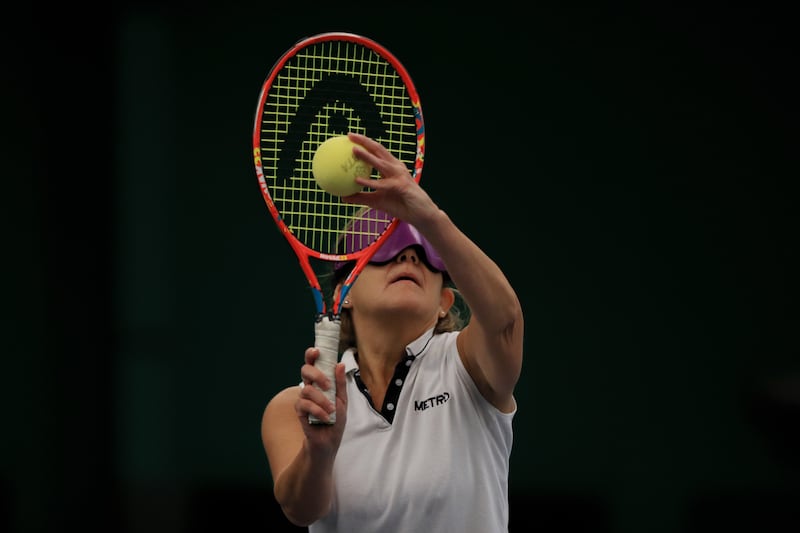The Queen’s Club championship usually means one thing – the tennis greats are assembling in London in preparation for Wimbledon.
Sure, it might seem a bit pretentious, but in some ways, it’s the truth. There was one big difference this time. ActionAudio, which makes tennis viewing accessible for the blind and visually impaired through a series of bleeps and bloops alongside commentary, debuted its technology in the northern hemisphere after a successful show for the Australian Open.
B1 tennis player (in layman’s terms, that’s no sight at all) Naqi Rizvi is glad to see one of his favourite sports finally embrace his differences and include him in the game for those without a disability.
Naqi was born with congenital glaucoma, which meant his sight deteriorated quite quickly, leaving him blind at a very young age. His family didn’t care and ensured he competed in a variety of sports, including martial arts, cricket and now tennis.
Rose Zhang joins list of investors in TGL golf league
Five things we learned from the GAA weekend: Michael Murphy’s comeback grabs the headlines and Kerry have a Clifford conundrum
What time is kick-off and what TV channel is Wales v Ireland on? All you need to know about the Six Nations clash
Justin Kluivert’s new-born child proves quite the inconvenience for dedicated fantasy football managers
“Sport has been one of those things that has been really important to me when I was young. My dad kind of wanted to make sure that I could still enjoy life and do things that other people could as well.
“It started off with everything, from going to theme parks and rollercoasters, which I still love, through to doing martial arts and other sports like cricket and stuff. So sports was an important part of my life growing up, but it was more just for fun,” explains Naqi from his flat in London.
We all know how crucial recreational sport is for our physical and mental health and Naqi soon had to discover how to do things for himself without his parents’ guidance when he moved out to go to university.
Sporting opportunities weren’t readily available for Rizvi in Alfaisal University (Riyadh, Saudi Arabia) but then a masters opportunity came by in 2015 and Rizvi discovered his love for sport while in the UK. And thus, emerged tennis, the sport in which Rizvi has become an international powerhouse.
“With tennis, it’s slightly adapted, so blind tennis or visually impaired tennis was actually started in Japan not too long ago. And the basic premise, as you can imagine, instead of hand-eye coordination, it is hand-ear coordination with the ball as it has a rattle in it.
“It’s slightly bigger than a mainstream tennis ball, and it’s slightly softer as well. Because if you get hit in the face, it’s not very pleasant because obviously you can’t anticipate because you can’t see where the ball is. So the ball has a rattle in it, which means that you can hear where the ball is every time it bounces. And then, the baseline of a tennis court is tactile, such as the tram lines or the edges of the terminal.
“It’s to give you an idea of where you are on the court. If you’re in a rally, then, a lot of times, the centre mark would also be tactile because obviously, in the middle of the rally, you need to orientate yourself. As an example, before I serve, I obviously can’t make eye contact or anything like that. So I would say, are you ready? They’d say yes, I say play, and then we play ball. So it’s slightly adapted.”

There are categories ranging from B1-B5. B1 is completely blind and goes up through the percentage of vision through the remaining categories. There are also some rule changes, with B1 competitors allowed three bounces of the ball as opposed to two bounces for B2s and B3, whereas B4 and B5 get one bounce.
Naqi understands he’s in a total of 1% of the population as a top-class athlete. There are many tennis fans who have a visual impairment and still can’t access the game they love. Without ActionAudio beeps and bloops, they rely on a carer or plus one to relay information.
If they’re relying on commentators, some commentate differently, some use imagery or call out sights and sounds, and others go historical and decide to go on match-long soliloquies about a player’s uncle. For those with sight, we can figure out the stops and starts. Those with an impairment are relying solely on the commentator to paint a picture.
“Tennis is one of those sports which is incredibly visual. And you know, there are different styles of playing it. And while you can listen to the commentary, it doesn’t always do it justice because, obviously, it’s a really fast-paced game as well. And it’s really difficult to describe every type of shot as well. And that’s what I found, whenever I’ve tried to watch tennis, either live or on the television, it’s just not been great, because obviously, it’s not very descriptive.
“And because with commentary there’s a struggle to kind of follow what exactly is happening, sometimes you might be able to make some sense, let’s say if someone’s tried a drop shot because it is a really different sound, or if someone’s tried to volley because then you don’t hear the bounce of the ball. But generally, it’s really hard to make sense of what’s happening.
“And you always feel that you never really get enough information, let alone all the information that you would like, and the more options we can provide to people to be able to have that sensory experience with something like ActionAudio will actually be really great.”
Radio commentary enhances the experience, according to Naqi, because everyone is in the same boat without having visuals. However, the visually impaired listener still doesn’t have all the information for couch analysis afterwards with their friends.
Another struggle for Naqi is accessing ticket portals for big events. Wimbledon’s website, for example, isn’t accessible for visually impaired patrons and the venue itself is relatively hilly, making patrons unsteady.
Add to that a lot of the tickets are in obstructed areas. As Naqi so eloquently put it: “They just assume because we can’t see our view can be obstructed and we wouldn’t know”.
For now, Naqi is waiting for more tennis tournaments to pick up on ActionAudio and asking more organisers to be aware of the various abilities of the patrons flooding their gates annually.
“Disability obviously is, for many people, a permanent reality, but there are lots of others who are temporarily or situationally disabled, and you know, things like this [inclusive design] could benefit other people as well.
“If someone isn’t at home and isn’t watching tennis on the telly, and are just in a park with a family, they could benefit from ActionAudio, not just someone who was visually impaired or blind like me. I think it’s about thinking about inclusive design from that perspective, rather than just for a more niche audience.”

















